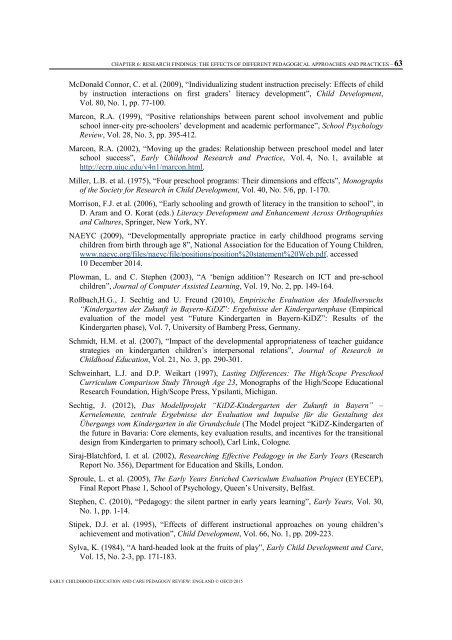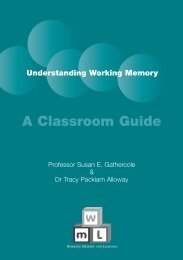early-childhood-education-and-care-pedagogy-review-england.pdf?utm_content=bufferb49b1&utm_medium=social&utm_source=twitter
early-childhood-education-and-care-pedagogy-review-england.pdf?utm_content=bufferb49b1&utm_medium=social&utm_source=twitter
early-childhood-education-and-care-pedagogy-review-england.pdf?utm_content=bufferb49b1&utm_medium=social&utm_source=twitter
Create successful ePaper yourself
Turn your PDF publications into a flip-book with our unique Google optimized e-Paper software.
CHAPTER 6: RESEARCH FINDINGS: THE EFFECTS OF DIFFERENT PEDAGOGICAL APPROACHES AND PRACTICES – 63McDonald Connor, C. et al. (2009), “Individualizing student instruction precisely: Effects of childby instruction interactions on first graders’ literacy development”, Child Development,Vol. 80, No. 1, pp. 77-100.Marcon, R.A. (1999), “Positive relationships between parent school involvement <strong>and</strong> publicschool inner-city pre-schoolers’ development <strong>and</strong> academic performance”, School PsychologyReview, Vol. 28, No. 3, pp. 395-412.Marcon, R.A. (2002), “Moving up the grades: Relationship between preschool model <strong>and</strong> laterschool success”, Early Childhood Research <strong>and</strong> Practice, Vol. 4, No. 1, available athttp://ecrp.uiuc.edu/v4n1/marcon.html.Miller, L.B. et al. (1975), “Four preschool programs: Their dimensions <strong>and</strong> effects”, Monographsof the Society for Research in Child Development, Vol. 40, No. 5/6, pp. 1-170.Morrison, F.J. et al. (2006), “Early schooling <strong>and</strong> growth of literacy in the transition to school”, inD. Aram <strong>and</strong> O. Korat (eds.) Literacy Development <strong>and</strong> Enhancement Across Orthographies<strong>and</strong> Cultures, Springer, New York, NY.NAEYC (2009), “Developmentally appropriate practice in <strong>early</strong> <strong>childhood</strong> programs servingchildren from birth through age 8”, National Association for the Education of Young Children,www.naeyc.org/files/naeyc/file/positions/position%20statement%20Web.<strong>pdf</strong>, accessed10 December 2014.Plowman, L. <strong>and</strong> C. Stephen (2003), “A ‘benign addition’? Research on ICT <strong>and</strong> pre-schoolchildren”, Journal of Computer Assisted Learning, Vol. 19, No. 2, pp. 149-164.Roßbach,H.G., J. Sechtig <strong>and</strong> U. Freund (2010), Empirische Evaluation des Modellversuchs“Kindergarten der Zukunft in Bayern-KiDZ”: Ergebnisse der Kindergartenphase (Empiricalevaluation of the model yest “Future Kindergarten in Bayern-KiDZ”: Results of theKindergarten phase), Vol. 7, University of Bamberg Press, Germany.Schmidt, H.M. et al. (2007), “Impact of the developmental appropriateness of teacher guidancestrategies on kindergarten children’s interpersonal relations”, Journal of Research inChildhood Education, Vol. 21, No. 3, pp. 290-301.Schweinhart, L.J. <strong>and</strong> D.P. Weikart (1997), Lasting Differences: The High/Scope PreschoolCurriculum Comparison Study Through Age 23, Monographs of the High/Scope EducationalResearch Foundation, High/Scope Press, Ypsilanti, Michigan.Sechtig, J. (2012), Das Modellprojekt “KiDZ-Kindergarten der Zukunft in Bayern” –Kernelemente, zentrale Ergebnisse der Evaluation und Impulse für die Gestaltung desÜbergangs vom Kindergarten in die Grundschule (The Model project “KiDZ-Kindergarten ofthe future in Bavaria: Core elements, key evaluation results, <strong>and</strong> incentives for the transitionaldesign from Kindergarten to primary school), Carl Link, Cologne.Siraj-Blatchford, I. et al. (2002), Researching Effective Pedagogy in the Early Years (ResearchReport No. 356), Department for Education <strong>and</strong> Skills, London.Sproule, L. et al. (2005), The Early Years Enriched Curriculum Evaluation Project (EYECEP),Final Report Phase 1, School of Psychology, Queen’s University, Belfast.Stephen, C. (2010), “Pedagogy: the silent partner in <strong>early</strong> years learning”, Early Years, Vol. 30,No. 1, pp. 1-14.Stipek, D.J. et al. (1995), “Effects of different instructional approaches on young children’sachievement <strong>and</strong> motivation”, Child Development, Vol. 66, No. 1, pp. 209-223.Sylva, K. (1984), “A hard-headed look at the fruits of play”, Early Child Development <strong>and</strong> Care,Vol. 15, No. 2-3, pp. 171-183.EARLY CHILDHOOD EDUCATION AND CARE PEDAGOGY REVIEW: ENGLAND © OECD 2015



